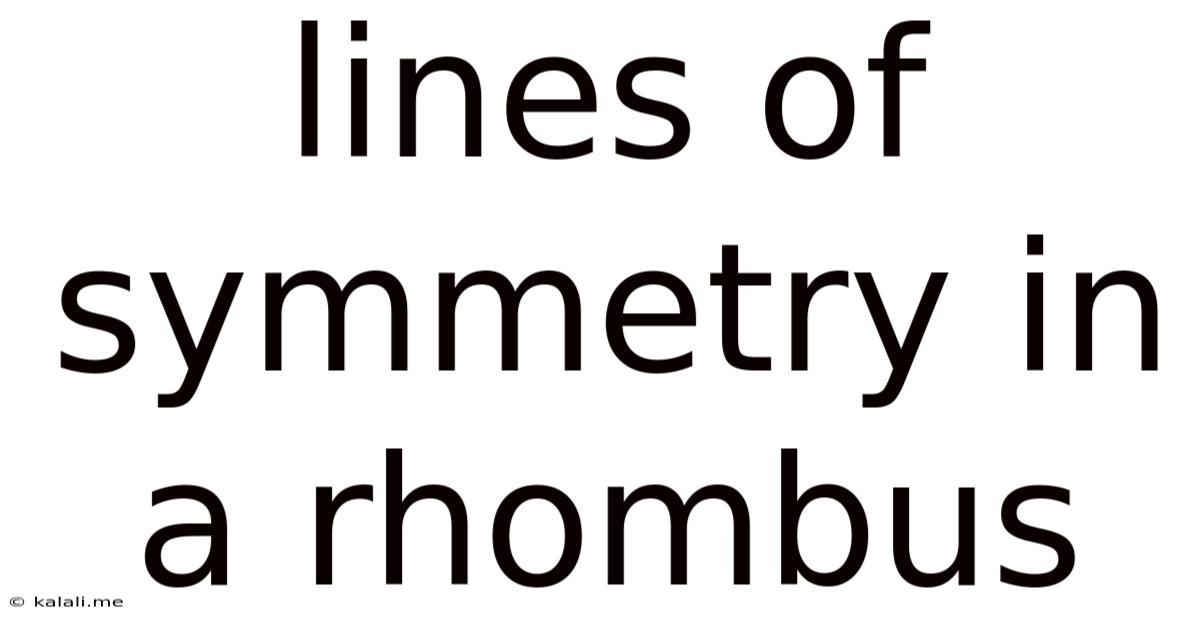Lines Of Symmetry In A Rhombus
Kalali
Jun 11, 2025 · 3 min read

Table of Contents
Lines of Symmetry in a Rhombus: A Comprehensive Guide
Meta Description: Discover the fascinating world of rhombus symmetry! This guide explores the lines of symmetry in a rhombus, explaining their properties and providing clear examples. Learn how to identify and draw them effectively.
A rhombus, a quadrilateral with all sides equal in length, possesses a unique set of properties, including its lines of symmetry. Understanding these lines is crucial for various mathematical applications and geometrical problem-solving. This article will delve into the specifics of a rhombus's symmetry, clarifying any confusion and providing a comprehensive understanding of this geometric concept.
What is a Line of Symmetry?
Before exploring the lines of symmetry within a rhombus, let's define the term itself. A line of symmetry, also known as a line of reflection, divides a shape into two identical halves that are mirror images of each other. If you were to fold the shape along this line, both halves would perfectly overlap.
Identifying Lines of Symmetry in a Rhombus
Unlike a square, which has four lines of symmetry (two diagonals and two lines through the midpoints of opposite sides), a rhombus has only two lines of symmetry. These lines are:
- The two diagonals: A rhombus has two diagonals. These diagonals intersect at a right angle and bisect each other. Crucially, each diagonal acts as a line of symmetry, dividing the rhombus into two congruent triangles. This means that if you were to fold the rhombus along either diagonal, the two halves would perfectly overlap.
Why Only Two Lines of Symmetry?
The reason a rhombus only has two lines of symmetry, unlike a square which has four, lies in its specific properties. While all sides of a rhombus are equal, its angles are not necessarily all equal (unless it's a square, a special case of a rhombus). This difference in angle measurement restricts the number of lines that can perfectly bisect the shape into mirror images. Only the diagonals fulfill this condition.
Distinguishing a Rhombus from a Square
It's important to distinguish between a rhombus and a square. A square is a special type of rhombus where all four angles are right angles (90 degrees). Because of this, a square possesses the additional two lines of symmetry that pass through the midpoints of opposite sides. A rhombus, however, only possesses symmetry along its diagonals.
Practical Applications and Examples
Understanding lines of symmetry in a rhombus has practical applications in various fields:
- Art and Design: Artists and designers frequently use rhombuses and their symmetry in creating patterns and tessellations. Understanding the lines of symmetry helps in creating balanced and visually appealing designs.
- Engineering and Architecture: Rhombuses are used in structural designs, and understanding their symmetry helps in optimizing strength and stability.
- Mathematics: Lines of symmetry are a fundamental concept in geometry and are used extensively in various mathematical proofs and problem-solving.
Conclusion
The lines of symmetry in a rhombus are a fundamental aspect of its geometric properties. By understanding these lines – the two diagonals – you gain a deeper appreciation for the shape’s inherent characteristics and its applications in different fields. Remember that understanding the difference between a rhombus and a square is key to correctly identifying its lines of symmetry. This understanding forms a crucial base for further explorations in geometry and related fields.
Latest Posts
Latest Posts
-
How Many Tbsp In A Dry Ounce
Jul 02, 2025
-
How Do You Say Grandparents In Spanish
Jul 02, 2025
-
How Many Numbers Are Between 48 To 24
Jul 02, 2025
-
How Many Positions Are There In Sex
Jul 02, 2025
-
How Many Minutes Are In 10 Miles
Jul 02, 2025
Related Post
Thank you for visiting our website which covers about Lines Of Symmetry In A Rhombus . We hope the information provided has been useful to you. Feel free to contact us if you have any questions or need further assistance. See you next time and don't miss to bookmark.